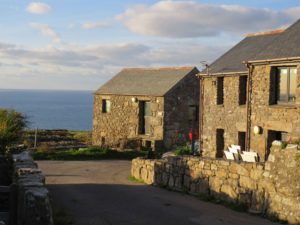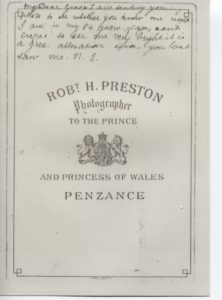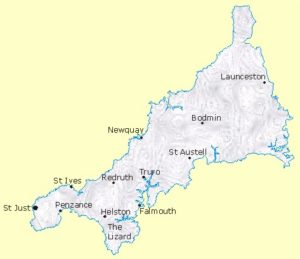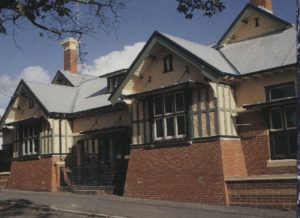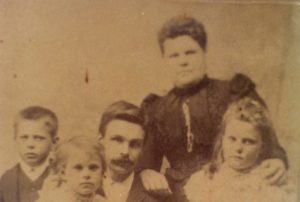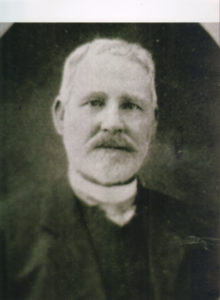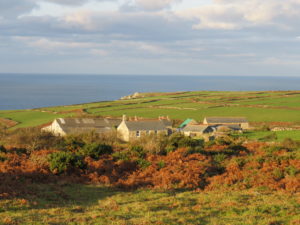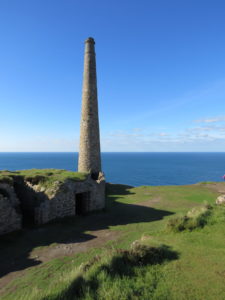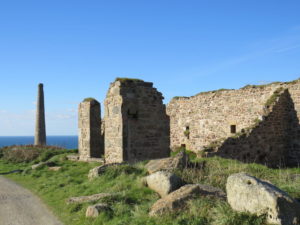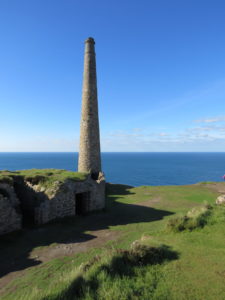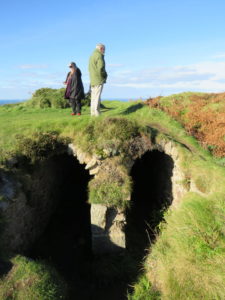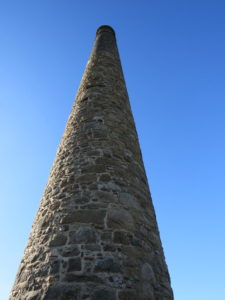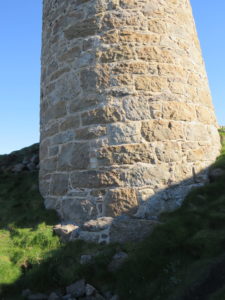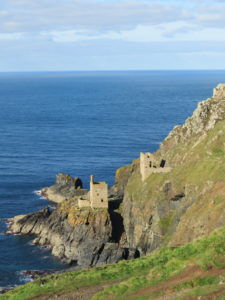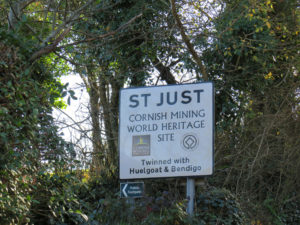
Sign at St Just, Cornwall
ST JUST, CORNWALL
The Ellis family can be traced back in St Just in Penwith, Cornwall for many centuries and also within the parishes of Constantine and Sancreed.
The family we are descended from lived at Boscaswell Row from 1841 to 1851. Boscaswell, Boscaswell Lower, and Levant are some of the hamlets encompassed by the parish of Pendeen. The area has been rich in tin mining, farming and fishing from remote times. Bronze and Iron Age relics dating from 4000 BC can be found in the surrounding moorland hills and ancient sites such as Pendeen Fogou and Pendeen Carn are nearby. Standing stones, and monuments can be readily seen in fields in the surrounding district.
In 1991 Elwyn Kinnane, with Dot and Wayne, visited Cornwall, staying with Betty and Larry Phillips at Purlands in Redruth near Truro. We drove to the remains of an Iron Age village and climbed inside the chamber gouged out of the hillside. We were alone in this eerie landscape. It is located near St Just and called Fogou Carn Euny. Fogou derives from the Cornish meaning cave. Once inside, the dimensions of this cave could be realised. It is a 65 feet (or around 20 metres) dry stone structure, roofed with massive stone slabs. It was incredible to think standing inside it, that our ancestors could have been standing in the same spot there thousands of years beforehand.
St Justers, it is said are used to wind and wild weather. Reportedly ‘St Justers do carry stones in their pockets for to keep theirselves from blowing away’. St Just in Penwith is located on the west tip of the Cornish peninsula where the weather can be very windy with squalls coming in from the Atlantic Ocean. The coast is rugged and treacherous and there have been many shipwrecks in the district. It is just six miles from Penzance, known for its pirates (that Gilbert & Sullivan made famous in Pirates of Penzance).
EARLIEST FAMILIES

The Old Churchyard, St Just
Our ELLIS family can be traced back to Joseph GILES and Elizabeth ANGWIN.
1550s Origin of the ANGWIN surname
In 1554 Queen Mary I, a Catholic, married Phillip II of Spain. They presented Benedict (or Bennet) Lethon to the Living (or benefice) of St Just on 18 May 1557. Lethon was a celibate or unmarried priest. Benedict Lethon was appointed Vicar of St Just in 1557 and Rector of Phillack (Hayle) at which latter place he died and was buried on 22 February 1581. He lived at St Just and held two Livings by Authority of Cranmer, Archbishop of Canterbury with Royal Authority. At Cranmer’s death Archbishop Parker became Primate of all England and enquired about Lethon holding Phillack. His reply came from the Bishop of the Diocese of Exeter. ‘DOM: Benedictus Lethon Rector, Non Graduatus, Presbyter non conjugatus nol concumninaerius, satis doctus non predicat.’ [Translation: Master Benedict Lethon, Rector, Non graduate priest. Neither married nor with concubine. Doctrine satisfactory. Nothing said against him.’
When Queen Mary I died in 1558 Elizabeth I succeeded to the throne, at which time she allowed the clergy to marry. Benedict Lethon took advantage of the licence and married. This was the start of the Angwin’s. Benedict Lethon had several sons. The eldest took the name of the estate in St Just that his father bought for him, and became known as John BUSVARGUS. This name died out a century ago. The youngest son was nicknamed ANGWIN and his name appears in the Parish Registers and his children’s names as
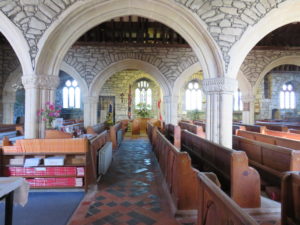
Interior, St Just Church
LETHON-ALIAS ANGWIN
Soon the name LETHON disappeared and gave way to ANGWIN. One presumes that the lad was fair of hair or countenance because ANWIN means ‘the white’ or ‘fair’. AN means ‘the, and GWIN means ‘white’ or ‘fair’. The emphasis is on the second syllable NGWIN. The name entirely belongs to St Just.
In 1811, Margaret ANGWIN married William (Bill) Bolitho’s grandfather’s grandmother, and John Pearce’s (who researched this) grandmother’s grandmother. Martin ANGWIN married Jane USTICK Sep 1686 and is the great grandfather of Margaret Wearne (sometimes Warren) who is the great great grandmother of Eleanor Stevenson ELLIS. Martin ANGWIN is the 7 x great grandfather of Dorothy Wickham (Dark/Kinnane). Our family is thus related to many Cornish families. Sir Humphrey Davey’s mother was a Busvargus from St Just.
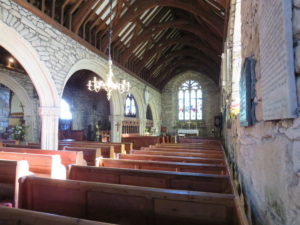
Interior, St Just Church
1650s
A unique document, the Cornwall Hearth and Poll Taxes for the St Just Parish 1660-1664 was preserved.
A translation shows that:
Wee whose names are under written doe freely and voluntarily engage and to be true and faithfull to his highness The Lord Protector against foraigne invaders or dysturbers of the peace of this antion as it is now settled under the comand of his highness wheresoere wee bee thereunto required of the defence of Y country to the utmost of o’power and hereunto have subscribed o’hands the first day of May 1658 under the command of Captain Francis Adundall.
Y is the old short way of writing TH O is the short for ‘our’ Thus Ye is really ‘the’ The first sheet of the document opens with the signature of William Busvargus and the second sheet with the signature of Malachias Angwin. On the right had side of the first shet is the name Paskow Ellis with some sort of floral signature. The three signatures at the bottom of the last page are probably constables and we find Thomas Ellis’ signature amongst them. Other familiar names on the list are Davey, Thomas, and Tonkin.
The Lord Protector of the Commonwealth was Oliver Cromwell.

Gravestones of Thomas Ellis, who died 1 January 1858, aged 69 years, Thomas Ellis (his grandson) who died 4 September 1894, aged 55 years and Emily his daughter who died 28 May 1852 aged 17 years. Peter, the son of Thomas & Mary Ellis who died 20 June 1857 aged 3 months. Also of Thomas died 16 September 1868 aged 54 years Mary died 28 October 1902 aged 82 years. Pendeen Church Graveyard.
Peter Ellis of St Just in Penwith, Cornwall was the tenant of Samuel Berlase Esquire in 1798 and 1799, according to the UK land Tax Redemption book 1798. A series of volumes giving details of redemptions of Land Tax from 1799 until 1953. Details shown in the volumes are (1) the name of the redemptioner, (2) the name of the occupant, (3) the amount of tax redeemed, and (4) the registered number of the redemption contract. The volumes were discontinued in 1953.
Thomas ELLIS who was born 21 February 1789 and acquitted of ‘wrecking’ in the Michaelmas Quarter Sessions was the father of Peter ELLIS. Thomas ELLIS senior married Mary DAVEY (1792-1878) on 1 January 1814.
Peter ELLIS and Ann TONKIN were the parents of Thomas ELLIS. Michael DAVEY and Margaret WEARNE were Mary Davey’s parents.
MINERS
The St Just region is known for its tin and copper mining. Mining in Cornwall and Devon, in the southwest of England, began in the early Bronze Age, around 2150 BC, and ended (at least temporarily) with the closure of South Crofty tin mine in Cornwall in 1998. Tin, and later copper, were the most commonly extracted metals. Some tin mining continued long after the mining of other metals had become unprofitable. Historically, tin and copper as well as a few other metals (e.g. arsenic, silver, and zinc) have been mined in Cornwall and Devon. … In view of the economic importance of mines and quarries, geological studies have been conducted; about 40 distinct minerals have been identified from type localities in Cornwall. Quarrying of the igneous and metamorphic rocks has also been a significant industry. https://en.wikipedia.org/wiki/Mining_in_Cornwall_and_Devon
Around the 16th century when open cast mining was used, German miners who had knowledge of the techniques were employed. Many of the terms of Cornish mining are German because of the great influx of German metallurgists into Cornwall in the 1600s. Among the terms are the titles of ‘Cap’n’ to signify foreman. The Cap’ns and their wives held a high place in the social strata of the parish. In 1689, Thomas Epsley, a Somerset man, developed a method to blast the very hard granite rock loose, using gunpowder with quill fuses. It revolutionised hard rock mining. Six days’ work with a pick could be accomplished with one blast. Miners were not paid wages but joined together to work a mine, and called themselves ‘adventurers’. Cap’n William Warren was an adventurer in Carnyorth Mine (on Bolitho land) and struck upon native copper, that is, copper almost pure and free from dross.
Every month the miners sold their tin or copper individually. Some months they had nothing, mostly sufficient to live on, but once in a life time a bonanza. Cap’n Warren’s bonanza enabled him to be married to Margaret Angwin in 1811 and to build half a dozen granite houses for his children. William Warren and Margaret Angwin were married at St Just Church and their seven children were baptised there. They were: William (9 Aug 1812 – died before 1822); Benjamin (11 Dec 1814-); Margaret (18 July 1817 – married William Bolitho son of Margaret Thomas and Walter Bolitho); MaryAnn (7 Apr 1820-); William (28 Jun 1822 -) and Elizabeth (15 Nov 1825 -).
The Ellis and Warren families residing at Boscaswell Row, St Just according to the 1841 and 1851 Census Records for that Parish, and were tin and copper miners. Thomas Ellis aged 50 and Peter Ellis aged 24 in 1841 were tin miners, as was William Warren aged 30 years. By 1851 Peter Ellis aged 34 years was a tin and copper miner, his father Thomas Ellis aged 62 years was a ‘Miner in the tin mines’. William Warren had died by 1851 leaving his widow Elizabeth Warren aged 64 at 131 Boscaswell Row, with her son Richard aged 23 years a ‘miner in a tin mine’ and her daughter Peggy Warren aged 20 a mantua maker. Further, the brother of Peter Ellis, Thomas Ellis aged 36 years was a miner.
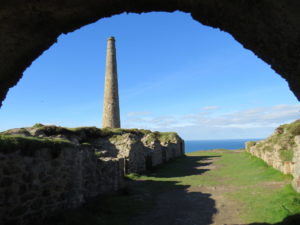
Chimney, Levant Mine, near St just, Cornwall

Levant Mine, near St just, Cornwall
WRECKERS
Wreckers of St Just, Cornwall, lured ships into the coast where the vessels foundered, broke up, and sank, costing many lives. The merchandise was then looted. This story concerns Thomas Ellis born 1789 and his son Thomas Ellis born 1814. The excerpt on this page was taken from Life in Cornwall in the Mid-nineteenth Century. Extracts from the West Briton newspaper in the two decades 1835 to 1854. Selected and edited by R. M. Barton, page 41, and dated 20 October 1837.
Michaelmas Quarter Sessions
Thomas Ellis senior 58 and Thomas Ellis junior 24 were indicted for stealing a quantity of staves from the wreck of a French ship, called Le Randais which was wrecked on the coast of St Just. Richard Pearce (agent of Lloyd’s) went to St Just; arrived there about half past 12 at noon; he went to a place called Boscriggan. He found a vessel on the shore in pieces, and the things coming on shore consisting of wine, bales of cotton, many thousands of staves, cases of wine, and other articles. There were probably a couple of thousand persons present, and the number was afterwards increased to about 4000 … On seeing the younger prisoner with the staves, prosecutor (Pearce on behalf of the French Government) told him to immediately to restore the staves, but her refused to do it.
When he was carrying off the staves there were a great many persons about him, and prosecutor told them that he had been obliged to have the assistance of the Revernd Mr Buller to read the riot act, and he was determined to make an example of some one of them. He then seized the younger prisoner by the collar and dragged him some distance … turning around [he] saw the elder prisoner make a blow at him which he received on his hat and hand. The staves which the younger prisoner dropped when he was taken into custody were carried off, and witness never saw anything more of them. This vessel was completely stripped by the wreckers of whom Ellis junior was by no means the worst offender. In consequence he was given only six months hard labour for his minor offence, with a recommendation to mercy, whilst Ellis senior was acquitted.
Peter ELLIS was baptised at St Just Cornwall on 10 November 1816.
He married his cousin Nancy Fanny ROBYNS on 24 August 1841 at St Just, Cornwall.
They resided at Boscaswell Row in 1841 with their close relatives.
They remained in Boscaswell Row according to th 1851 Census of St Just in the parish of Pendeen.
EUREKA
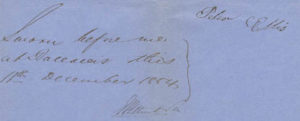
Signature of Peter Ellis on an Official Document concerning the Treason Trials and the arrest of men of his party after Eureka
The battle of Eureka occurred on 3 December 1854 at the Ballarat East Goldfield.
Peter ELLIS was residing on the Eureka Lead, Ballarat East, in Australia by 1854 with a party comprising James Wearne, goldminer and his wife Patience Wearne (nee White), John Penaluna, goldminer, Henry Read, and Joseph Penrose, goldminer, all from St Just, Cornwall. The Cornish were excellent miners, and well versed in deep mining techniques.
The emigration records of Peter Ellis are yet to be found, and it is possible that he came to Burra Burra in South Australia before venturing to Ballarat and the goldfields of Victoria. Because he is listed with his wife, Nancy Robyns, on the 1851 British Census, as residing in Boscaswell Row, it is presumed he emigrated to Australia between 1851 and 1854. It is also feasible that families in St Just were in contact with those in Australia (such as James and Patience Wearne who were with Ellis’ party, and who had emigrated in 1849 to South Australia before answering the lure of gold). Their daughter, Elizabeth Wearne, wrote a diary about their journey and life, so it is through this source that we know a little about their lives and what happened to them.
Patience and James Wearne (in Ellis’ party) had emigrated with 385 other passengers, many of them St Justers, to Australia from Plymouth on the vessel William Money. This vessel left Bristol/Plymouth around 19 September 1848 and arrived in Port Adelaide, South Australia, on 3 January 1849. Many suffered from fever and dysentery before the vessel reached Adelaide, according to surgeon superintendent A. C. Kemball. The 834 ton vessel also carried coals, boards and window glass.
James Wearne worked at the Burra Burra mines in South Australia but took ill with colonial fever. Patience opened an infant school to help with finances. When gold was discovered in Victoria James proceeded to the Bendigo diggings leaving Patience behind. She sold out and travelled to Melbourne on the vessel Reliance with some friends. They then settled at Castlemaine before travelling to Ballarat, packing their tent and belongings in a dray. Their daughter, Elizabeth, wrote that she was nursing a little puppy some one had given her while she was riding along, and sadly, a jolt sent it off her lap and the wheel went over it.
By 1854 the Wearne family were living with other Cornish people at Specimen Hill, Ballarat. Elizabeth, who was around five years old, remembered an incident when the police rode down the gully to try and find miners working without a licence. In November 1854 two huge meetings were held in Ballarat with over half the region’s population attending. The Ballarat Reform League was formed with aims similar to those of the Chartist movement in Britain. The goldfields were a melting pot of over 30 different nationalities, many of whom had fled the troubles of 1848 in Europe. The government reacted brutally and without mercy.
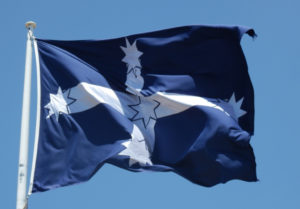 The unrest culminated early one Sunday morning when troops attacked the Eureka Stockade. Around 30 were killed and about 130 were arrested. Elizabeth remembered the battle where her mother, Patience Wearne, reportedly hid a digger beneath her skirt after the Eureka battle. There are reports of women saving miners in this way, and of the troopers and soldiers bayonetting through the women’s crinolines. Of those arrested, thirteen were charged with High Treason, an offence punishable by death.
The unrest culminated early one Sunday morning when troops attacked the Eureka Stockade. Around 30 were killed and about 130 were arrested. Elizabeth remembered the battle where her mother, Patience Wearne, reportedly hid a digger beneath her skirt after the Eureka battle. There are reports of women saving miners in this way, and of the troopers and soldiers bayonetting through the women’s crinolines. Of those arrested, thirteen were charged with High Treason, an offence punishable by death.
Patience Wearne (nee White) was born at St Just Cornwall, England. She married James Wearne on 29 June 1847 at Trewellard Methodist Church, Cornwall. The Wearne’s lived at Boscaswell Row and were neighbours of Peter Ellis. Her husband, James Wearne, was born on 9 November 1824 to James Wearne and Elizabeth Davey. James Wearne and Peter Ellis had common great grandparents, Richard Wearne and Mary Giles, so were not only neighbours, but related to each other.
Two of Ellis’ party were arrested and charged with High Treason. James Wearne gave evidence during the Eureka Treason Trials in 1855 claiming he lived near Henry Read, and was a friend of Penneluna, Penrose and Peter Ellis. James said that he heard the firing at Eureka and got up. He saw men from his small mining entourage, Read, Penneluna and Penrose go towards Bakery Hill and he saw Penrose and Read taken away in custody. Peter Ellis also gave evidence saying that he was in his tent which was near Read’s, on the morning of 3rd December and saw the prisoners a little way from the Catholic Chapel. Henry Read was wearing cord trousers and a blue shirt. Another Cornishman, John Peneluna, had seen Read and Penrose in their tent the night before and was called by Penrose to see the soldiers go past. When Read and Penrose were arrested, the other men in the party went to Melbourne as witnesses, but could not convince the authorities that their mates had nothing to do with the Eureka Affair. After being gaoled for twelve months they were let off.
